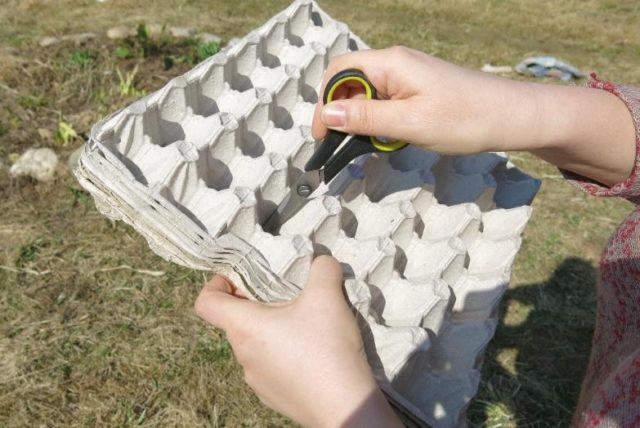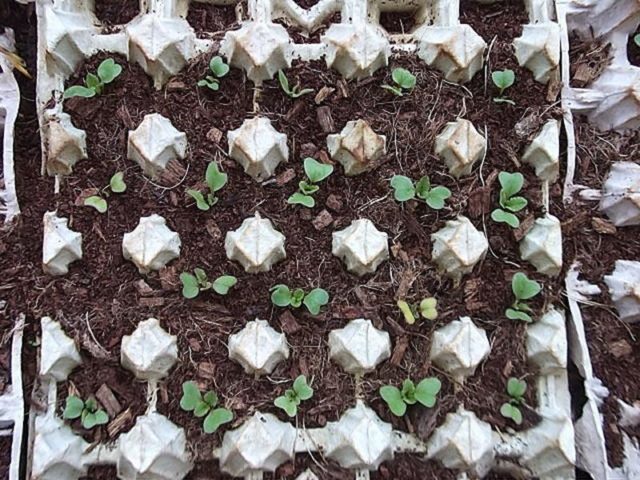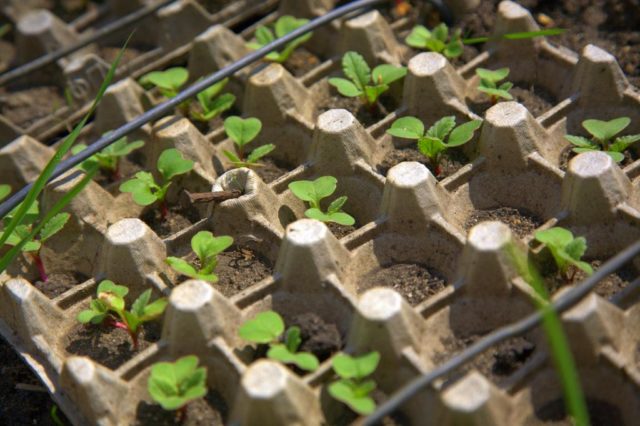Content
Planting radishes in egg cells is a new method of growing crops that has many advantages over the standard method. This early root vegetable is a favorite vegetable for many gardeners, but not everyone decides to grow it, arguing that it is difficult to prepare the soil after radishes for planting other plants. However, a solution has been found: the procedure can be simplified by growing the culture in egg cells.
Advantages of growing radishes in egg trays
Growing radishes in egg cells has many advantages:
- saving planting material;
- convenience of sowing small radish seeds in separate cells;
- no weeds;
- seedlings do not need thinning;
- There is no need to mulch or loosen the soil afterwards.
Preparing the beds
Radishes should not be placed in areas with high groundwater levels; excess moisture can cause cracking of the roots. The soil for radishes must be fertile, sandy loam or loamy, neutral or slightly acidic. The soil must also contain at least 3% humus.
The place for the beds needs to be dug up to the depth of a spade bayonet, and then the ground should be leveled with a rake. During digging, the soil should be fed with organic and mineral fertilizers. For 1 sq. m will need:
- 5 - 6 kg of humus;
- 30 g double granular superphosphate;
- 30 g potassium sulfate.
Planting radishes in egg cells
Even a beginner can cope with planting radishes in egg trays. However, in order to get an early and rich harvest, you need to familiarize yourself with some rules.
Preparing seeds and egg trays
First of all, you need to start preparing the egg cassettes. They require special treatment, since in some cases, chickens can be carriers of salmonellosis: the causative agents of this dangerous disease for humans, along with bird droppings, end up on eggshells. In order not to infect the ground for planting radishes through contact with egg cassettes, they are wiped with alcohol or heated in the oven at a temperature of 70 degrees.
After processing the bottom side of each cassette, it is necessary to cut off the tops of the cells using a sharp stationery knife or scissors. The result should be through holes, with which the cassettes should be directed downwards when placed on the ground.
If you use your own collected radish seeds, it is recommended to treat them with “Tiram” before planting.Treatment with this preparation will further protect radishes planted in egg cells from the formation of root rot. Seeds purchased in a store, as a rule, do not require processing, since it has already been carried out by the manufacturers. If desired, the seeds can be germinated before sowing by soaking in warm water for 12 - 16 hours.
How to sow radishes in egg cells
The optimal time for planting work is considered to be the spring season. The beginning of spring is more preferable, but, first of all, it is necessary to build on climatic conditions. Seeds begin to germinate at temperatures from 3 degrees Celsius.
The main rule for sowing radish seeds in egg cassettes is that each seed must be placed in a separate cell. Radish seeds have almost 100% germination rate, therefore, if several are planted in one cell, the seedlings will subsequently have to be thinned out, thereby causing damage to the root system.
Algorithm for sowing radishes in egg cells:
- Place the prepared egg cells in the selected area, pressing them into the soil so that the soil begins to protrude slightly from the holes. This allows you to avoid a gap between the soil and the cassettes, into which the seeds can fall.
- Secure the cassettes with staples made of ordinary wire so that they are not blown away by the wind.
- Sort the seeds, removing all debris. Choose the largest ones. Place one seed in each cell and sprinkle with river sand.
- Water generously.
The egg cells are sprinkled with sand rather than soil, since sand has several advantages: it does not form a crust after drying, and during harvesting it is enough to simply shake it off, and the root crops will become clean.
There is another way to plant radishes in egg cells:
- Dig up and then loosen the soil by adding crushed eggshells and ash while digging.
- Place the prepared egg cells on the garden bed.
- Pour water over the cells until they are soaked.
- Pour some humus into the bottom of the cells.
- Place the seeds and cover with a small layer of soil.
- Water.
- Sprinkle again with soil mixed with humus, then water again.
After sowing the seeds, the bed must be covered with film until the first shoots appear, not forgetting to ventilate regularly. As a rule, seeds begin to germinate and actively sprout within about a week.
How to grow radishes in egg cells
Subsequent care of radishes in egg trays is quite simple. The optimal air temperature for this crop is from 16 to 20 degrees Celsius. Young plants will be able to withstand short-term cold snaps of up to 3 degrees below zero, but during prolonged frosts they will die.
It is important to remember that, like all root vegetables, radishes prefer moist soil (the recommended soil moisture level is 60 - 70%) and do not tolerate drought.If the soil is not sufficiently moistened, the root vegetables will grow small and their skin will become dense and rough. If overmoistened, the foliage will begin to turn yellow and cracks will form on the root crops.
Radishes growing in egg trays are best watered daily with small portions of water. Otherwise, the surface layer of the soil mixture may dry out. The optimal time for watering is in the evening after sunset. When watering, you should always focus on the air temperature and amount of precipitation. During cold weather, the frequency of watering should be reduced to three times a week.
Radishes in egg trays can be watered in another way:
- 2 - 3 times a week - during drought and heat;
- Once a week - in rainy weather.
Water consumption in this case, on average, should be about 10 liters per 1 sq. m.
If the soil was well fertilized before planting, then additional fertilizing is not required; it can provoke the accumulation of nitrates in root crops. Root crops planted in sand do not need to be loosened, since a crust does not form on it after watering. The earthen soil is periodically loosened, and it should also be mulched with a layer of peat or humus to prevent excessive evaporation of moisture.
The ripening period for root crops is about 30 days.
Pests and diseases
Of the pests, radishes are mainly threatened by cruciferous flea beetles. You can get rid of them using ash, tansy infusion, soapy water solution or dusting with tobacco dust.
In addition to cruciferous flea beetles, root vegetables can be attacked by various beetles, butterflies and slugs. As folk remedies to repel pests, fertilizer from slurry and spraying of plants with tincture of dope or henbane are used.
Conclusion
Planting radishes in egg cells greatly facilitates the process of growing crops, which is why this method is becoming increasingly popular. The technology helps to obtain a rich, high-quality harvest, which during growth nothing can interfere with or harm. At the same time, harvesting only becomes easier; you just need to lightly pull the tops - and the root crops will leave the egg cells without much effort.













